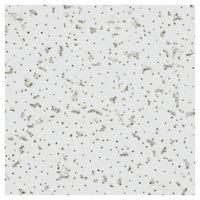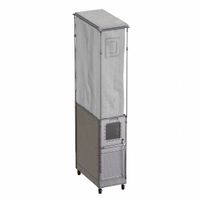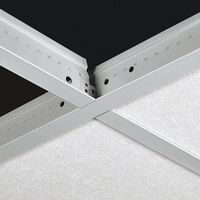Call +(254) 703 030 000 / 751 483 999 / 721 704 777
- Home
- Furnishings Appliances Hospitality
- Furnishings Building Supplies
- Ceiling Tiles Hanging Hardware
Frequently Asked Questions
What are the benefits of using ceiling tiles in suspended ceilings?
Ceiling tiles in suspended ceilings offer several benefits:
1. **Aesthetic Appeal**: Ceiling tiles come in various designs, colors, and textures, allowing for customization to match interior decor and enhance the visual appeal of a space.
2. **Acoustic Control**: Many ceiling tiles are designed to absorb sound, reducing noise levels and improving acoustics in environments like offices, schools, and auditoriums.
3. **Easy Access**: Suspended ceilings provide easy access to plumbing, electrical, and HVAC systems. Tiles can be removed individually for maintenance or repairs without disturbing the entire ceiling structure.
4. **Thermal Insulation**: Certain ceiling tiles offer thermal insulation properties, helping to maintain temperature control and reduce energy costs by minimizing heat loss or gain.
5. **Fire Resistance**: Some ceiling tiles are manufactured with fire-resistant materials, contributing to building safety by slowing the spread of fire and providing additional time for evacuation.
6. **Moisture and Mold Resistance**: Specialized tiles resist moisture and inhibit mold growth, making them suitable for areas with high humidity, such as bathrooms and kitchens.
7. **Cost-Effectiveness**: Ceiling tiles are generally affordable and easy to install, making them a cost-effective solution for both new constructions and renovations.
8. **Durability and Longevity**: High-quality ceiling tiles are durable and can withstand wear and tear, ensuring a long lifespan with minimal maintenance.
9. **Light Reflection**: Some tiles are designed to reflect light, enhancing natural and artificial lighting, which can reduce the need for additional lighting fixtures and lower energy consumption.
10. **Environmental Benefits**: Many ceiling tiles are made from recycled materials and are recyclable, contributing to sustainable building practices and reducing environmental impact.
How do you install ceiling tiles into a grid system?
To install ceiling tiles into a grid system, follow these steps:
1. **Preparation**: Ensure the room is ready by removing any existing ceiling fixtures and clearing the area. Measure the room dimensions to determine the number of tiles and grid materials needed.
2. **Grid Layout**: Begin by installing the main runners of the grid system. These are typically installed every 4 feet. Use a laser level or chalk line to ensure they are straight and level. Secure them to the ceiling using appropriate fasteners.
3. **Cross Tees Installation**: Insert cross tees between the main runners to form a grid pattern. These are usually spaced 2 feet apart, creating a 2x2 or 2x4 foot grid depending on the tile size.
4. **Perimeter Molding**: Attach L-shaped perimeter molding along the walls at the desired ceiling height. This supports the edges of the tiles and provides a finished look.
5. **Tile Cutting**: Measure and cut tiles to fit around the perimeter of the room and any obstacles like light fixtures or vents. Use a utility knife or tile cutter for precise cuts.
6. **Tile Installation**: Begin placing full tiles into the grid, starting from the center of the room and working outwards. Tilt each tile slightly to fit it into the grid, then lay it flat.
7. **Adjustments**: Ensure all tiles are level and adjust as necessary. Make sure the tiles fit snugly within the grid without gaps.
8. **Final Touches**: Install any ceiling fixtures, such as lights or vents, by cutting tiles to accommodate them and securing the fixtures to the grid.
9. **Inspection**: Check the entire ceiling for any misaligned tiles or gaps and make necessary adjustments.
This process results in a clean, professional-looking ceiling.
What types of ceiling tiles are best for high-humidity areas?
For high-humidity areas, the best types of ceiling tiles are those specifically designed to resist moisture and prevent mold and mildew growth. Here are some suitable options:
1. **PVC Ceiling Tiles**: Made from polyvinyl chloride, these tiles are waterproof and resistant to mold and mildew. They are ideal for areas with high humidity, such as bathrooms and kitchens.
2. **Metal Ceiling Tiles**: Typically made from aluminum or stainless steel, metal tiles are impervious to moisture and do not warp or degrade in humid conditions. They are durable and easy to clean, making them suitable for commercial kitchens and industrial settings.
3. **Fiberglass Ceiling Tiles**: These tiles are made from spun glass fibers and are coated to resist moisture. They are lightweight, offer good sound absorption, and are resistant to mold and mildew, making them a good choice for basements and other damp areas.
4. **Mineral Fiber Ceiling Tiles with Moisture Resistance**: Some mineral fiber tiles are treated to enhance their moisture resistance. These tiles can be used in areas with moderate humidity but should be checked for specific ratings to ensure suitability for high-humidity environments.
5. **Vinyl-Faced Gypsum Ceiling Tiles**: These tiles have a vinyl surface that provides a moisture barrier, making them suitable for areas with occasional exposure to humidity. They are often used in healthcare facilities and laboratories.
When selecting ceiling tiles for high-humidity areas, it is crucial to consider the specific environmental conditions and choose tiles with appropriate moisture resistance ratings. Additionally, proper installation and ventilation are essential to ensure the longevity and performance of the ceiling tiles in humid environments.
How do ceiling tiles help with sound reduction and privacy?
Ceiling tiles contribute to sound reduction and privacy by utilizing their acoustic properties to absorb, block, and diffuse sound. These tiles are typically made from materials like mineral fiber, fiberglass, or foam, which have porous surfaces that trap sound waves, reducing echo and reverberation within a space. This absorption capability is quantified by the Noise Reduction Coefficient (NRC), with higher values indicating better sound absorption.
In addition to absorption, ceiling tiles can also block sound transmission between rooms. This is measured by the Ceiling Attenuation Class (CAC), which indicates the tile's ability to prevent sound from passing through the ceiling into adjacent spaces. Tiles with a high CAC rating are effective in maintaining privacy by minimizing sound leakage.
Furthermore, the installation of ceiling tiles creates a barrier that can help contain sound within a room, preventing it from traveling to other areas. This is particularly beneficial in open-plan offices, schools, and healthcare facilities where maintaining confidentiality and reducing noise pollution are crucial.
Ceiling tiles also contribute to sound diffusion, scattering sound waves to prevent them from concentrating in one area. This helps create a more balanced acoustic environment, enhancing speech intelligibility and reducing distractions.
Overall, the combination of sound absorption, blocking, and diffusion provided by ceiling tiles enhances acoustic comfort and privacy, making them an essential component in the design of spaces where noise control is a priority.
What is the purpose of the plenum space in a dropped ceiling?
The plenum space in a dropped ceiling serves several critical functions in building design and infrastructure. Primarily, it acts as a concealed area for housing and distributing building services such as HVAC (heating, ventilation, and air conditioning) systems, electrical wiring, plumbing, and communication cables. This space allows for easy access to these systems for maintenance, repairs, and upgrades without disrupting the occupied areas below.
One of the key purposes of the plenum space is to facilitate air circulation. In many commercial buildings, the plenum acts as a return air pathway for HVAC systems. Air is drawn from the occupied spaces into the plenum, where it is then returned to the HVAC system for reconditioning. This setup can improve energy efficiency by reducing the need for additional ductwork and allowing for more even temperature distribution.
Additionally, the plenum space contributes to sound attenuation. The gap between the dropped ceiling and the structural ceiling can help reduce noise transmission between floors, enhancing acoustic privacy and comfort in multi-story buildings.
The plenum also provides flexibility in building design and layout. As technology and building needs evolve, the plenum space allows for relatively straightforward modifications to electrical and communication systems without significant structural changes. This adaptability is particularly valuable in commercial and office environments where technological upgrades are frequent.
However, it is important to note that materials used in the plenum space must meet specific fire safety standards, as the area can contribute to the spread of smoke and fire if not properly managed. Overall, the plenum space is a vital component in modern building design, offering practical solutions for infrastructure management, air distribution, and acoustic control.
How do you maintain and clean ceiling tiles to prevent mold and sagging?
To maintain and clean ceiling tiles and prevent mold and sagging, follow these steps:
1. **Regular Inspection**: Check ceiling tiles regularly for signs of moisture, discoloration, or sagging. Early detection helps prevent further damage.
2. **Control Humidity**: Maintain indoor humidity levels between 30-50% using dehumidifiers or air conditioners. Proper ventilation in areas like bathrooms and kitchens is crucial.
3. **Fix Leaks Promptly**: Repair any roof or plumbing leaks immediately to prevent water damage to ceiling tiles.
4. **Clean Tiles Regularly**: Dust tiles with a soft brush or vacuum with a brush attachment. For deeper cleaning, use a mild detergent solution and a soft cloth. Avoid soaking the tiles.
5. **Use Mold-Resistant Products**: Consider installing mold-resistant ceiling tiles, especially in high-humidity areas.
6. **Ensure Proper Insulation**: Adequate insulation in the attic or above the ceiling tiles can prevent condensation, which can lead to mold growth.
7. **Replace Damaged Tiles**: Replace any tiles that show signs of mold, water damage, or sagging to prevent the spread of mold and maintain the ceiling's structural integrity.
8. **Seal Tiles**: Apply a sealant to tiles to provide an additional barrier against moisture.
9. **Professional Cleaning**: For extensive mold or dirt, hire professional cleaning services to ensure thorough and safe cleaning.
10. **Monitor Temperature**: Keep indoor temperatures consistent to prevent condensation on ceiling tiles.
By following these steps, you can effectively maintain and clean ceiling tiles, preventing mold growth and sagging, and ensuring a healthy indoor environment.
What are the considerations for using ceiling tiles in cleanroom-rated systems?
When selecting ceiling tiles for cleanroom-rated systems, several critical considerations must be addressed to ensure compliance with cleanliness standards and operational efficiency:
1. **Material Composition**: Ceiling tiles should be made from non-shedding materials like coated metal or high-density mineral fiber to prevent particle generation. They must resist microbial growth and withstand frequent cleaning.
2. **Cleanliness Class**: The tiles must meet the specific ISO cleanroom classification, which dictates the maximum allowable particle count. This ensures the tiles do not contribute to contamination.
3. **Sealing and Installation**: Tiles should be installed with a gasketed grid system to create a tight seal, preventing air leaks and particle infiltration. The installation must be flush and secure to maintain the integrity of the cleanroom environment.
4. **Chemical Resistance**: Tiles must withstand exposure to cleaning agents and disinfectants used in cleanrooms without degrading or releasing particles.
5. **Fire Resistance**: Compliance with fire safety standards is crucial. Tiles should have appropriate fire ratings to ensure safety without compromising cleanroom integrity.
6. **Load-Bearing Capacity**: Consideration of the weight of equipment or fixtures that may be mounted on or near the ceiling is necessary to ensure structural integrity.
7. **Acoustic Properties**: While not always a primary concern, sound absorption can be important in certain cleanroom environments to reduce noise levels.
8. **Light Reflectance**: High light reflectance can improve illumination efficiency, reducing energy costs and enhancing visibility for tasks.
9. **Maintenance and Durability**: Tiles should be easy to clean and maintain, with a long lifespan to minimize replacement frequency and associated downtime.
10. **Cost and Availability**: Budget constraints and the availability of materials that meet all the above criteria must be considered to ensure a cost-effective solution.
These considerations ensure that ceiling tiles contribute to maintaining the stringent environmental controls required in cleanroom operations.


